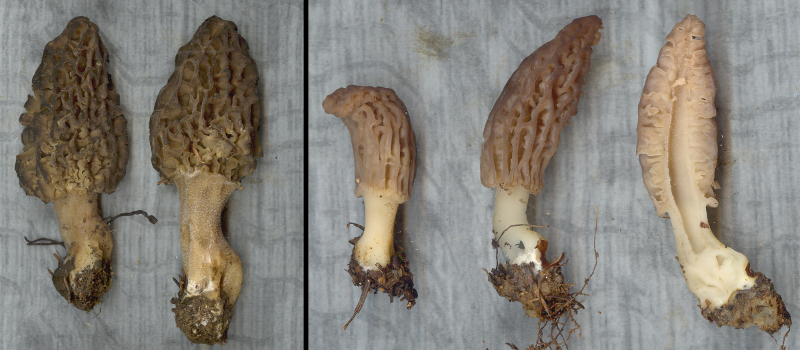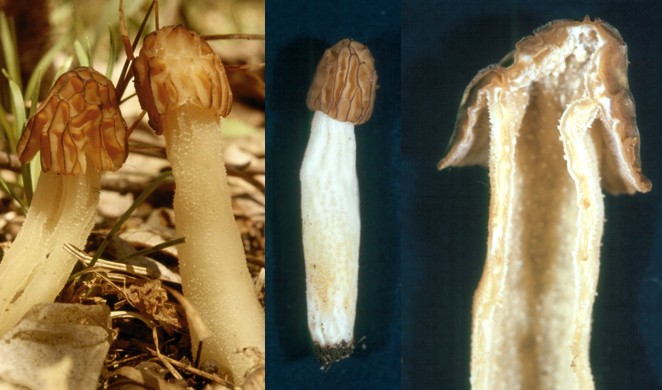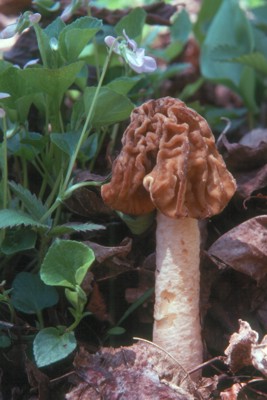Home >> Diversity and classification >> True fungi >> Dikarya >> Ascomycota >> Discomycetes >> Operculate Discomycetes >> Stipitate Operculate Discomycetes
STIPITATE OPERCULATE DISCOMYCETES

A number of operculate discomycetes produce their apothecia at the top of a distinct stipe. The four pictures above show species of Helvella with various kinds of stipe and a variety of apothecia. At left is H. leucomelaena, a species having a very short and ribbed or fluted stipe, and a cup-shaped apothecium. The next panel shows H. silvicola, also with a short and fluted stipe but with a very one-sided cup that is exposed nearly to the base, making it scoop-shaped. The third panel shows the nearly pure white H. crispa. Here the apothecium is clearly saddle-shaped and the stipe is strongly grooved or fluted. Helvella lacunosa in the fourth panel also has a fluted stipe but the apothecium has become more folded and brain-like.. There are other variations on the Helvella theme in other species, but the stipe, however short, offers a clue to their identity. The apothecia, no matter how unusual, are always connected only to the top of the stipe, never along its sides.

Species of Gyromitra resemble those of Helvella in many ways but tend to be larger and less varied in colour. The three species in the photographs above are very typical in colour. Gyromitra esculenta, the species to the far left, is the most common one in our area, appearing in May in hardwood or mixed forests. The brain-like (cerebriform) structure of the apothecium is characteristic. Although G. esculenta is commonly eaten in Europe it can be fatally poisonous if not correctly prepared. Most books on the subject stress the importance of distinguishing this from the edible morel and recommend against eating it. The central panel illustrates Gyromitra infula a species common in our forests in the autumn. It has a saddle-shaped apothecium similar to those of some Helvella species. At right is a species that may be more confusing. This is G. perlata, a fungus that grows flat on the ground and has almost no stipe at all. It was long included in the genus Discina but genetic studies have show it to be a true Gyromitra.

At the other end of the scale are the morels, members of the genus Morchella. These have complex apothecia divided up into pit-like chambers separated by sterile ridges. The apothecia are completely attached to the stipe and are not even free at their rims. The stipe is relatively uncomplicated as in some Helvella species. Recognition of Morchella is important because its species are commonly collected for the table, even commercially, and must be distinguished from those of Helvella or Gyromitra, which may be dangerously poisonous. The identification of morels was once thought to be quite easy and to inolve as few as two species. The sequencing of DNA has now shown there to be many species, with field identification requiring close attention to minute details. The morels in the photos at left, both collected on the same day in northern New Brunswick, would even recently have been forced into the inappropriate species M. elata. We now know the one at left to be M. eohespera, a cosmopolitan species, and the one at right M. laurentiana, known so far only from New Brunswick and Newfoundland on the Gulf of St. Lawrence.

At right are three views of Mitrophora semilibera, sometimes called the half-free morel. It is very morel-like in its pitted apothecium and sterile ridges but differs in having the apothecium only partially connected to the stipe. This important feature is clearly seen in the right panel which shows a cross section of the entire fruiting body. A true morel would not have an apothecium with a skirt-like rim. Species of Mitrophora are similar enough to morels that some authors treat them as species of Morchella.

Verpa bohemica, figured at left, is one more variant among the stipitate operculate discomycetes. It resembles Mitrophora semilibera but differes in two ways. First of all, the apothecium is entirely free from the stipe, except at its apex, in the manner of a Giromitra species. Secondly, the apothecium is wrinkled rather than pitted and does not have sterile ridges as do species of Morchella and Mitrophora.